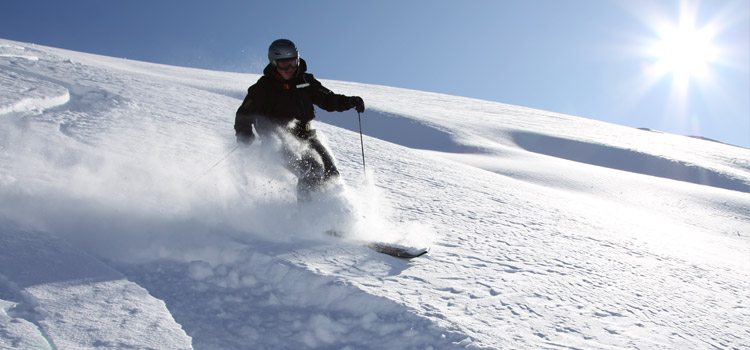
What is the best technique to use?
Here are the main components of a traditional technique which consistently work in powder skiing. Practice it and build up your confidence, you will soon feel at home in powder!
First, choose a slope steep enough to slide down at a steady pace; from a neutral, flat footed and centered stance, let your body sink down to a low position with your weight equally distributed on both skis.
Then, initiate your turn with a pole plant and a simultaneous up-motion, gently extending the body in the direction of the turn; this “up-unweighting” motion is obtained from pressing down your “two-ski platform” and getting a gentle bounce out of it.
Then, steer the skis underneath you with a gradual push of the knees -forward and into the turn-; the idea is to give the skis time to enter the turn and progressively steer them along a nice and smooth arc as the body sinks down again.
The key for a good turn in powder is to keep a well balanced position throughout the turn and maintain the solid “two-ski platform” from which you can get a nice rebound to start your next turn. Here are a few tips to help achieve this:
- keep your skis close together so they behave as one;
- make sure that during the rising movement hips and upper body move forwards and into the direction of the turn, so you don’t end up leaning back;
- keep your hands up in front of you, with a wider lateral spread than usual, to help the balance mechanism;
- make your movements slowly and smoothly.
Once you have managed to combine the basic elements in a fluid and steady sequence, with a two-footed stance and a balanced position, you’re on your way to link beautiful turns. All you need to do is keep your speed up and link turns close to the fall line (that is avoiding traverses); soon you establish a nice rhythm, your skiing becomes effortless, graceful … et voilà, you are now enjoying the wonderful floating sensation of powder skiing!
Do I need special skis for powder snow?
Yes, skis designed for powder skiing are different from the shaped skis you use on hard packed snow. They’ll make your powder experience way easier and much more enjoyable. Powder skis, or fat skis, are specialized extra-wide skis which provide exceptional flotation in deep snow. There is an enormous choice of fat/powder skis now on the market, with a -sometimes confusing- diversity of widths, lengths, shapes, flexes, cambers, etc… However, if you are a novice powder skier, you want skis that are not excessively wide, that have a soft flex and a standard camber or if any, a light “Rocker” (reverse camber) in the tip and tail. Providing you use the right length for your weight and ability, this type of skis should give you a good flotation, be easy to maneuver and allow for a smooth performance even if your technique is not perfect.
What’s a good snowboard for powder?
The size of the snowboard is really important for riding powder. A longer, wider board is recommended to ensure adequate flotation in deep snow. A powder specific snowboard makes a difference and you’ll be ready to float nicely without having to do any binding adjustments. An all-mountain snowboard can be fine also; however, consider setting your stance back to improve your powder riding. Using a park snowboard will not give you adequate flotation; it might make your riding much more tiring and frustrating, especially if you don’t have much experience in deep powder. While on a powder board you can float without having to sit back, riding on other kinds of boards will most likely require leaning back; if you have to lean back too much to keep your tip up, you’ll spend much more energy to turn and you’ll get tired faster.
Tips for riding powder
Speed is your friend. Maintaining a good speed will make your turns effortless and prevent you from getting stuck.
While keeping your speed up, turns must involve smooth, slow-motion manoeuvres; abrupt movements will get your board to dig into the snow and get buried.
Your body weight should be centered, or slightly back. Try to get your hips, knees and ankles to do most of the work; avoid leaning your upper body forward when you initiate a turn, as this will make the nose of your board dig in and send you crashing!
Bouncing up and down, taking advantage of the “up-unweighting” and “down-weighting” technique, will make it easier to turn. The “up” motion reduces the weight and facilitates the initiation of the turn, while the “down” motion sets your weight back onto the board and helps you complete the turn. As you bounce up, make sure you shift your weight into the direction of the turn.
When you feel like you’re floating left and right in a fluid rhythm, you’re doing it right; you are now surfing the powder and you are on your way to enjoy the best day of snowboarding you’ve ever had!
One more tip… powder is the best snow to do tricks in, as it makes for the softest landings and provides a nice cushion if you fall; however, getting up after a fall in deep snow can be really tricky for a snowboarder. The best technique consists of getting up on the toe side, facing uphill; often, you may have to roll over, first, in order to get in that position. Also, you may have to get on your knees and pack a pile of snow in front of you with your hands, so that you have something firm to push against and get yourself back onto your feet.
